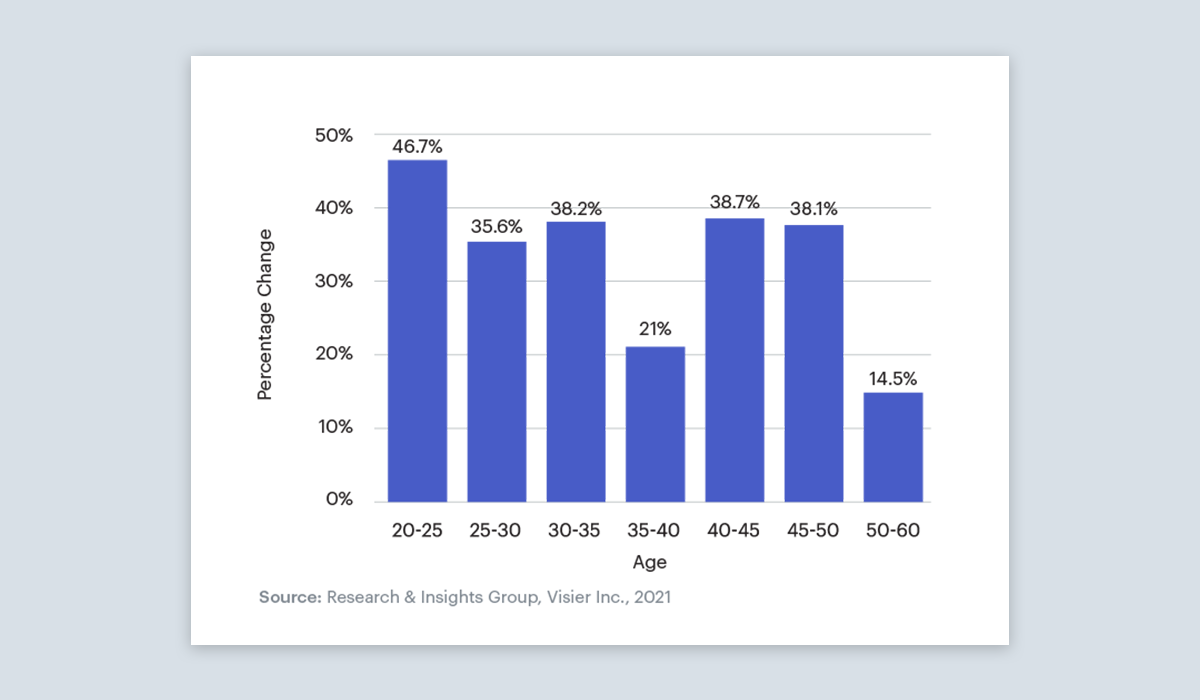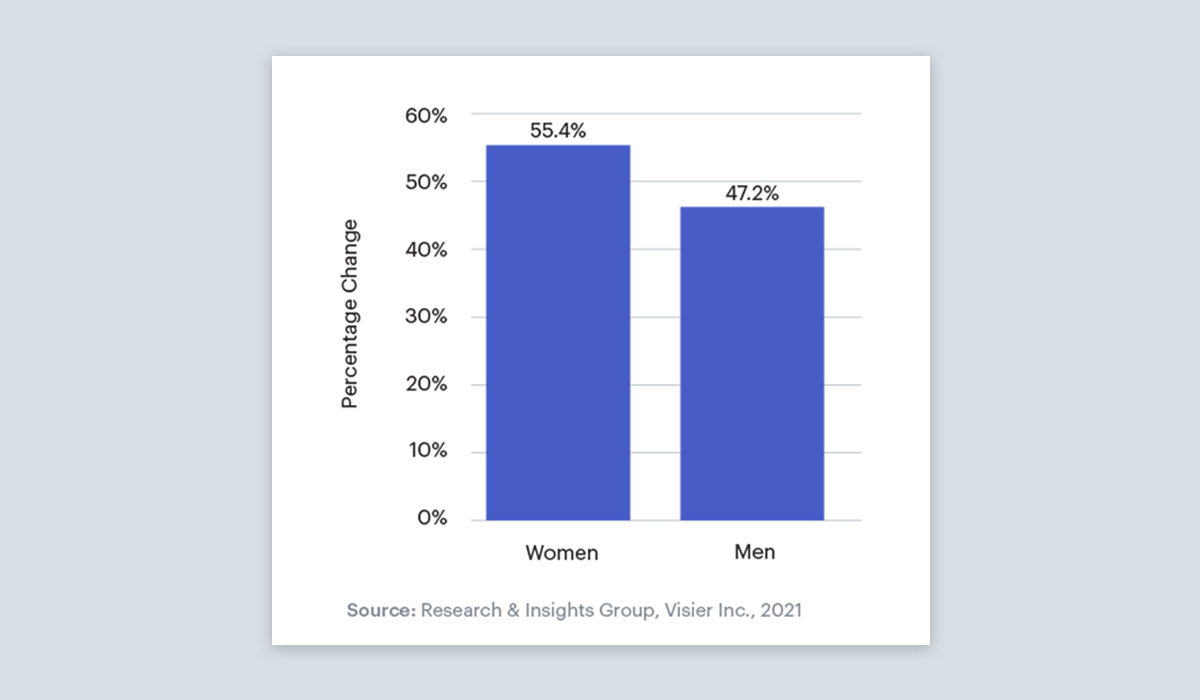Four Things We Learned About the Resignation Wave–and What to Do Next
Why did summer 2021 bring a wave of resignations, and which demographics were most affected? Find out and learn what to do next.

In 2020, the world hunkered down for a crisis. In 2021, businesses face a new one: a wave of resignations. Every demographic and every industry experiences normal churn, but these are not ordinary times. New Visier Insights research found a 25% annualized resignation rate compared to 22% in the same period in 2019, and 18% in a pandemic-ridden period January to August of 2020.
And despite what major news feeds focus on, people aren’t just quitting in food service and other low-level jobs. In addition to the usual resignation trends in younger, less tenured employee populations, new Visier Insights data shows unprecedented resignation rate changes of employees across tenures, or employees aged between 40-45 years, and women.
Below are some key findings from the report, Stop The Exit, and advice on how to act on them from our HR Super Leaders.
1. In 2020, people wanted to quit. In 2021, they actually did it.
Many organizations have been forecasting an elevated level of exits based on their survey data of employee sentiment. Visier Community Data showed that in 2021, employees followed through on their intent and actually made job changes happen in record volumes:

Monthly resignation rate across industries and demographics
There are many reasons employees quit their jobs and identifying the main driver will help your team craft the right retention plan to bring down turnover. “One of the places where the data showed us that we really needed to invest from a retention standpoint was performance equity,” said Emily Wu, Associate Director of People Analytics for Wayfair. “When we noticed that in the data there were performance inequities, we formed a Performance Equity Taskforce that was built from various cross-functional groups to essentially tackle the problem…from different angles.”
2. This resignation trend affects mid-tenured employees more
In most years, employees in less tenured groups lead in overall resignation rates. Between 2020 and 2021, that changed. The current resignation rate of employees with a 5-10 year tenure is 56.8% higher than in 2020, and for employees with a 10-15 year tenure, it’s 54.6% higher in 2021 than in the same period of 2020.

Percentage change of resignation rate by tenure
Career development isn’t just for younger or less-tenured employees. As a manager, having data-driven career pathing conversations with your mid-tenure team members is a good way to show them what’s possible for their next move internally and keep them interested in growing with your organization—as opposed to leaving for a different one.
This is the route that Hallie Bregman, Global Head of People Analytics at PTC, is taking: “We want to be able to take people who are in one role and say, ‘You have the skill. Here’s a great project that you could take advantage of and lean into that skill.’ It helps us retain our talent and helps us use folks more effectively.”
3. It’s not just young people quitting
In 2021, the 20-25 year age group had the highest increase in resignation rate. This age group tends to change jobs to accelerate their career and it’s likely they delayed their career moves due to the pandemic.
Surprisingly, employees aged 30-35, 40-45, and 45-50 have also all increased their resignation rates by more than 38%. These age groups are typically more stable and slow to change so their increased resignation rate suggests is indicative of the disruptive nature of this year’s resignation wave.

Percentage change of resignation rate by age
With so much disruption, it’s more important than ever to ask employees for what they want from your organization, listen to their answers, and implement changes in response as thoughtfully as possible.
“For every program that we have, we want to make sure that the programs are being optimized through data, that we’re being as impactful as we can, that we’re learning from our employees, what’s working and what’s not, and making quick course corrections,” advises Scott Judd, Senior Director of People Analytics at eBay.
4. Women are resigning at higher rates than men
Women have been resigning at higher rates than men for years, and this trend increased in the first eight months of 2021. This challenges employers who are losing their gender diversity, while providing an opportunity for employers who are able to create workplaces that support women.

Percentage change of resignation rate by gender
Use people analytics to hone in on what women and other groups at your organization may need in order to stay at your organization. Your analysis should also drill into what different cohorts within representative groups need so you’re not just applying a blanket solution that may not apply to, for example, women of color or younger women in the company.
“Visier can definitely help us with some of this,” says Lydia Wu, Head of Talent Analytics and Transformation at Panasonic North America. “We now understand that our women workforce is not just homogenous. We have working mothers. We have gen Zs who are just coming into the workplace. We have baby boomers who have had long careers and still have a lot to offer. So for us, from an HR perspective, it’s really about how do you build and sustain policies and programs that include that entire population.”
Tailored solutions are your new best friends
The current resignation wave is a worrying trend, especially in a time where employees are considered the most important stakeholder for your organization’s long-term success. But applying broad, generic solutions won’t work. Every company is different, every employee is different, and there’s no cost-effective panacea.
Gary Russo, the Executive Director of HR Workforce Intelligence at Providence, knows the value of listening and paying close attention to facts. “A lot of things people believe to be true are not supported by anything tangible,” he said. “Are we standing in our own way of getting to that right thing because we’re so attached to our past?”
Nuanced data about the populations with the biggest exit risk, the key drivers causing voluntary turnover, and the specific pockets in the organizations that are having the biggest issues will give HR and other leaders insight on how to target and mitigate future resignation risk. Analyzing this data is the first step towards stemming the tide of resignations and creating a workplace that puts its people first.
Continue learning about resignation:
Top 6 Reasons People are Quitting Their Jobs (and How to Keep Them)
Trends in Employee Resignation Rates: Watch Out for Summer 2021
The Surprising Reason People Quit Their Jobs That No One Talks About
On the Outsmart blog, we write about workforce-related topics like what makes a good manager, how to reduce employee turnover, and reskilling employees. We also report on trending topics like ESG and EU CSRD requirements and preparing for a recession, and advise on HR best practices how to create a strategic compensation strategy, metrics every CHRO should track, and connecting people data to business data. But if you really want to know the bread and butter of Visier, read our post about the benefits of people analytics.
Get the Outsmart newsletter
You can unsubscribe at any time. For more information, check out Visier's Privacy Statement.


